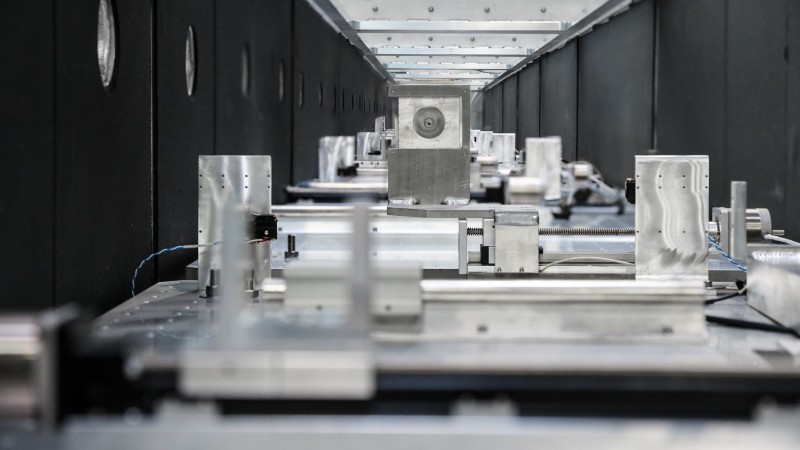Teams at the High Flux Isotope Reactor (HFIR), which restarted Oct. 29, took advantage of an extended outage to complete facility improvements and significant upgrades to 10 of 12 neutron beamline instruments.
Designed to provide new and important scientific capabilities, HFIR instrument upgrades included more advanced beam delivery systems, enhanced sample environments, better optics, and improved data acquisition systems and detectors.
Of the 10 instrument projects, five were considered major upgrades. They are:
- GP-SANS (General Purpose Small-Angle Neutron Scattering Instrument) and Bio-SANS (Biological Small-Angle Neutron Scattering Instrument)
The two SANS instruments were extensively upgraded, including new collimators (devices that produce parallel beams of neutrons) and larger, more robust vacuum vessels. Both also received new instrument control and data acquisition software to provide a common user interface at all ORNL SANS instruments, including those at the Spallation Neutron Source (SNS). The performance of materials is often intimately linked to the internal microstructure. GP-SANS provides information about materials in the range of 0.5-200 nm. Bio-SANS is designed for establishing an understanding between structure, function and dynamics of complex biological systems.
- FIE-TAX (Fixed-Incident-Energy Triple-Axis Spectrometer)
Redesigned monochromators (devices that select specified neutron wavelengths) were added to increase up to three times the number of neutrons delivered by the neutron beam, enabling the study of newly synthesized quantum materials earlier in the materials discovery cycle.
- FOUR-CIRCLE (Four-Circle Diffractometer)
A next-generation, neutron-sensitive Anger camera was installed to increase detector coverage and enable five to 10 times faster data collection. Enhancements to the sample environment include a motorized, computer-controlled platform for automated sample alignment. This instrument’s mission is to explore nuclear and magnetic structures as a function of temperature, pressure, magnetic field and electric field.
- NRSF2 (Neutron Residual Stress Mapping Facility)
An improved neutron detector and front-end optical system were installed to increase by up to three times the rate of experiments that can be performed and provide more detailed mapping of features inside samples. This instrument is designed to use the high penetration power of neutrons to map the spatially varying strain resulting from residual or applied stresses in bulk materials.
Other instrument improvements include:
- P-TAX (Polarized Triple-Axis Spectrometer)
The first of its kind in the US, technicians constructed a prototype spherical neutron polarimetry system (to characterize neutrons both before and after scattering) that includes a magnetically shielded sample environment. P-TAX is a versatile spectrometer to study static and dynamic properties of spin and lattice using polarized and unpolarized neutrons.
- POWDER (Neutron Powder Diffractometer)
Sample environment improvements included a high-strength magnetic field system and a three-sample changer cooled by liquid helium. This is a versatile instrument able to examine a variety of materials and is well-suited to studying new, complex, magnetically-ordered systems.
- IMAGINE (Image-Plate Single-Crystal Diffractometer)
A new goniometer (a device that rotates samples to precise angles) enables collecting complete data sets with fewer settings. This instrument’s high resolution enables researchers to study proteins and macromolecules, including those involved in processes such as biofuel production, the development of disease and drug design.
- WAND2 (Wide-Angle Neutron Diffractometer)
Stroboscopic measurement capabilities and a new humidity chamber were added. WAND is a versatile instrument with the ability to probe materials in extreme environments, collect data very fast, and study states of matter at low temperatures. It has value in chemical, quantum. biological and industrial materials research.
- IMAGING (Cold Neutron Imaging Beamline)
Teams installed a state-of-the-art system to measure SANS signals. This instrument is for neutron radiography and computed tomography for applications in additive manufacturing, materials science, geoscience, biology, energy and transportation.
The HFIR upgrades were supported by DOE’s Office of Science.
HFIR and SNS are DOE Office of Science User Facilities. ORNL is managed by UT-Battelle LLC for DOE’s Office of Science, the single largest supporter of basic research in the physical sciences in the United States. DOE’s Office of Science is working to address some of the most pressing challenges of our time. For more information, visit https://energy.gov/science –by Paul Boisvert




